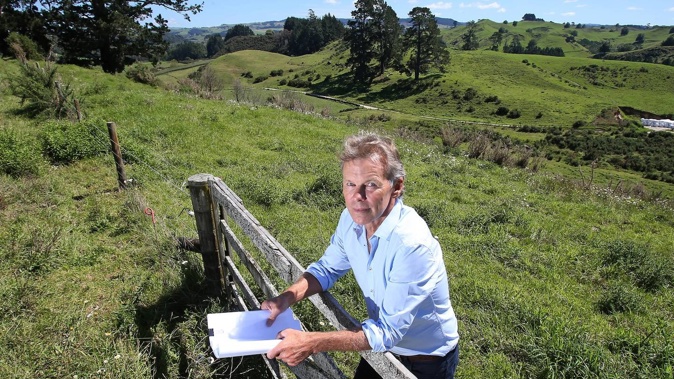
One of Tauranga’s largest prioritised areas for housing growth is trapped in “the ultimate catch-22″, unable to deliver the number of homes as planned until after local roading infrastructure is upgraded 27 years from now.
In 2021, government housing arm Kāinga Ora - Homes and Communities spent $70 million on 95ha of Ferncliff Farms at Tauriko West to help build an estimated 4000 homes in response to the city’s dire housing crisis.
Today, the Bay of Plenty Times can reveal developers can now only build half of that in the mid-term future because the Government roading arm was not expected to deliver on critical roading infrastructure before 2050. Last year, SmartGrowth Partnership warned a local housing shortage could reach 43,000 by 2048 due to the region’s ballooning population growth.
The city needs houses but they won’t be delivered until appropriate roading is, and this roading will only be delivered when there were enough houses to justify them.
It is a situation labelled “madness” and “the ultimate catch-22″ by one of Tauriko West’s three landowners.
Classic Group, Tauriko Business Estate and Kāinga Ora are eager to build but each was hamstrung by Waka Kotahi NZ Transport Agency’s decision not to upgrade State Highway 29 before 2050.
“That’s exactly it,” Classic Group director Peter Cooney said.
“Everyone wants housing yet we are stifled by infrastructure.”
Cooney said Classic Group’s development plans at Tauriko West were already “seven years into it, and we’re still struggling to get infrastructure on the ground”.
“Then when we do, we are restricted to build only so many houses.”
Cooney said Tauriko West was able to cater for about 4000 new homes but only about 2000 homes could be built until the SH29 overhaul was eventually delivered in 2050.
Despite this, work on these 2000 new homes could only begin once enabling works at Redwood Lane and Cambridge Rd, consisting of roundabouts, traffic lights and new pathways, were completed in an estimated three years’ time.
Cooney said that even if these works were fast-tracked to completion within two years, it still meant lon in delivery, which reduced the ability to provide affordable homes.
“That’s nine years. If this is going to be the case going forward - forget affordability,” he said.
/cloudfront-ap-southeast-2.images.arcpublishing.com/nzme/TDZBVAKFMFDVFCXLEDDUGM3Q2Q.jpg) Ferncliffe Farm, pictured in November 2021.
Ferncliffe Farm, pictured in November 2021.
“You can’t have pent-up demand like this. It [land] costs us millions and millions of dollars in holding costs and funding that has to go somewhere. It goes onto the consumer.”
Cooney said “it’s madness” the Government’s housing agency invested so much at Tauriko West when its transport agency would not provide the infrastructure in time to allow for the construction of all homes on this land.
“Yeah, you fund it but you can only build so many houses because you don’t have the roads, but, unless we build these houses you don’t get the roads. It’s the ultimate catch-22. It’s ridiculous that everyone wants housing but no one wants [the] infrastructure [to enable development].
“It really is a dire straits story,” Cooney said.
Cooney said funding options to help fast-track roading infrastructure such as toll roads or a localised GST to go towards future infrastructure were funding mechanisms that could be, and should be, considered.
In a Tauranga City Council meeting last month, Waka Kotahi’s Jess Andrew said after presenting the SH29 upgrade plans that it would monitor local traffic for “lead indicators” - meaning traffic congestion or roading demand - which could signal a potential need to bring the proposed project dates forward.
/cloudfront-ap-southeast-2.images.arcpublishing.com/nzme/67YTNOK3DZCNJASUZ6BABHUF6A.JPG)
However, Andrew told the Bay of Plenty Times afterwards the time was needed to allow for procurement and Resource Management Act processes.
This week, Tauriko Business Estate director Bryce Donne said off-site infrastructure such as transport, waste and water, had always been a significant constraint. While these were already addressed, to an extent, “the full build-out relies on future improvements, particular to the transport network”, he said.
The reliance on future improvements made “stacking up the project feasibility and funding the project very difficult if the developers need to construct nearly 100 per cent of the internal infrastructure, but can only deliver 60 per cent of the product”, Donne said.
“In order to create a thriving community at Tauriko West, it is important that [an] internal spine road is delivered as early as possible.”
Donne said the primary need was a safe and efficient route for freight and regional travel to enable the regional and New Zealand economy to prosper.
Donne said the business estate expected to build 750 to 800 homes on its land, depending on the final configuration.
The section of state highway from Omanawa Rd to Oropi roundabout was the single most important project in ensuring this was provided for, Donne said.
Physical construction was hoped to start about September 2024, he said.
The enabling works were expected to begin from late this year and provide capacity for a school and community facilities in addition to housing.
“Based on historic uptake, this should provide for 10 years residential land supply,” Donne said.
Kāinga Ora general manager of urban development and delivery Mark Fraser said it bought the Ferncliff Farm site to support increasing the supply of market, public and affordable housing by providing for a range of typologies (duplexes through to apartments), with a range of bedroom mixes.
“While plans for the development are still underway, it is estimated that around 1150 diverse new homes will be built on the site in the long term,” Fraser said.
About 500 Kāinga Ora homes were expected to be built first, through the delivery of the enabling works.
“Like the other landowners, we are aware that further infrastructure works will be required to deliver the remainder of the homes, and this was considered as part of our purchase decision,” Fraser said.
/cloudfront-ap-southeast-2.images.arcpublishing.com/nzme/B5YOVGNDNZEOPPQVLOWBMECMGQ.JPG)
“Housing delivery will start once the enabling works infrastructure is in place, estimated to be mid-late 2026.”
Fraser said Kāinga Ora’s intention was to align the delivery of civil works with the delivery of the infrastructure “so that housing delivery can begin as soon as these services are provided”.
“We continue to look for land acquisition opportunities that will help increase the pace, scale and density of urban development across the country, including in Tauranga.”
Tauriko West was one of five priority development areas in the Western Bay of Plenty and it was committed to responding to the critical housing need for the region, Fraser said.
Kāinga Ora has more than 430 public houses in Tauranga, with plans to establish another 200 outside of Tauriko West.
Western Bay of Plenty Infrastructure Forum chairman Nigel Tutt said Tauranga and the Bay of Plenty were at a critical juncture where unlocking the region’s full potential hinged on removing the SH29 bottleneck.
The lag on roading infrastructure was holding back “much-needed housing projects, stifling domestic manufacturing businesses, and threatening export growth and supply chain security”, Tutt said.
“By addressing this choke-point, we can unlock over 20,000 new greenfield homes, 6500 more jobs in the fast-growing industrial estate, and over 11,000 jobs along the transport corridor.”
Transport Minister David Parker said the Government was committed to improving roading infrastructure in the Bay of Plenty. This was demonstrated by its significant investments to date, including the Takitimu North Link stage one, Baypark to Bayfair link, and Waihī to Ōmokoroa projects.
The staged approach to roading projects helps ensure that they are delivered efficiently and with minimal disruption, Parker said.
Housing Minister Megan Woods’ office has been approached for comment. Questions included how the transport agency’s 2050 timeline for delivery of roading infrastructure aligned with the Government’s housing expectations of Tauranga, and what exactly was this expectation. The minister’s office was also asked whether expecting Tauranga to wait until 2050 before it could complete Tauranga West housing plans was acceptable, and how she would help better progress housing delivery here.
Kiri Gillespie is an assistant news director and a senior journalist for the Bay of Plenty Times and Rotorua Daily Post, specialising in local politics and city issues. She was a finalist for the Voyager Media Awards Regional Journalist of the Year in 2021.
Take your Radio, Podcasts and Music with you









